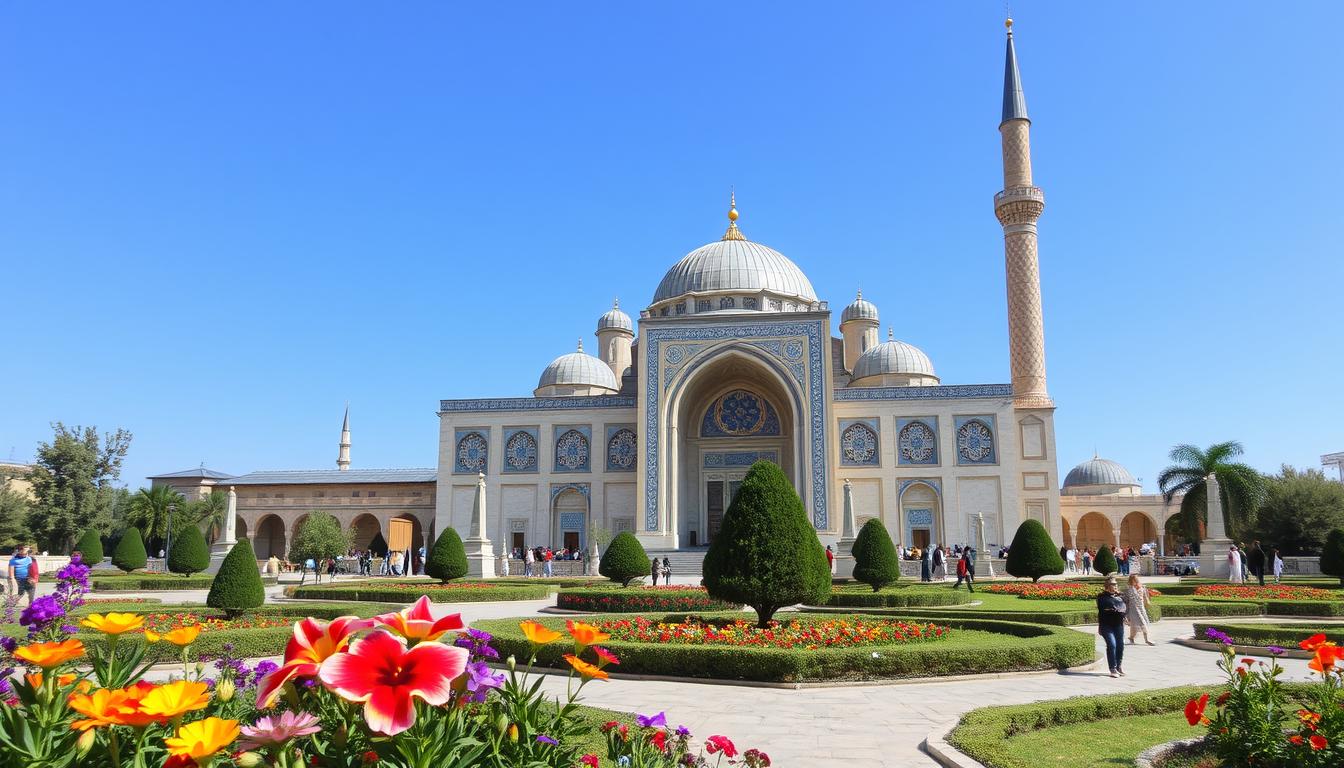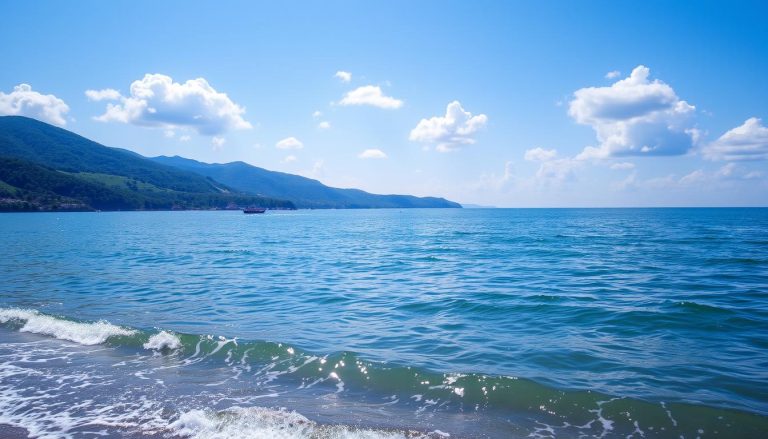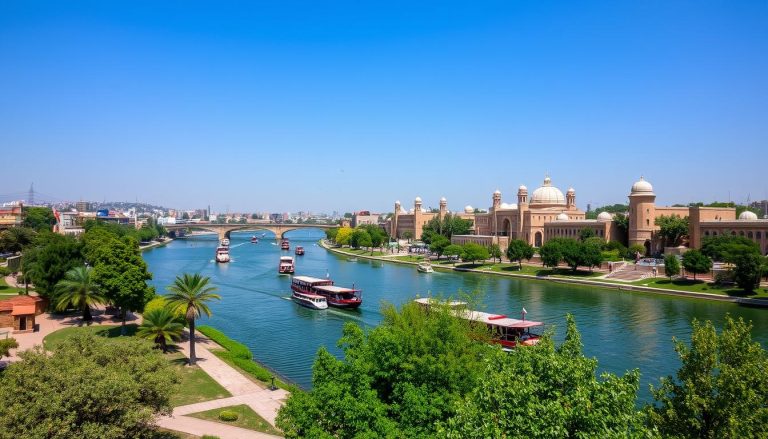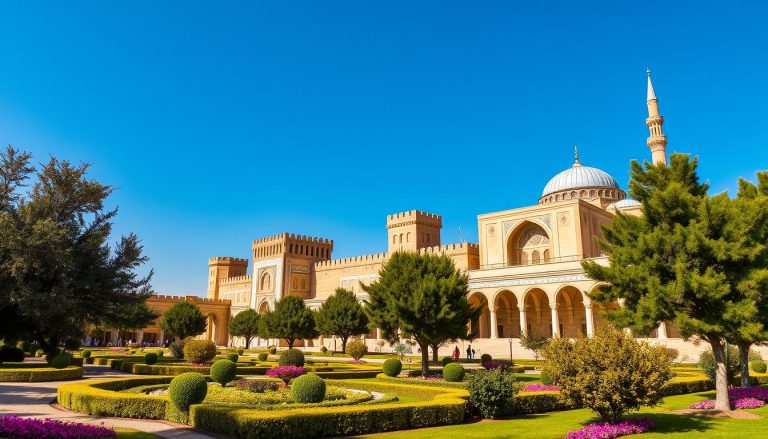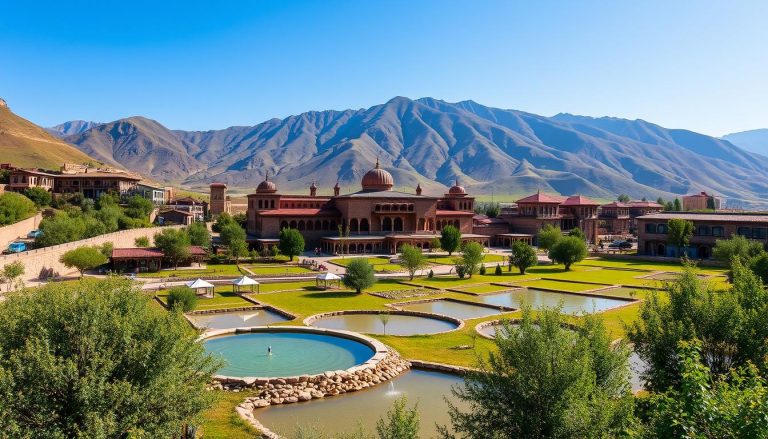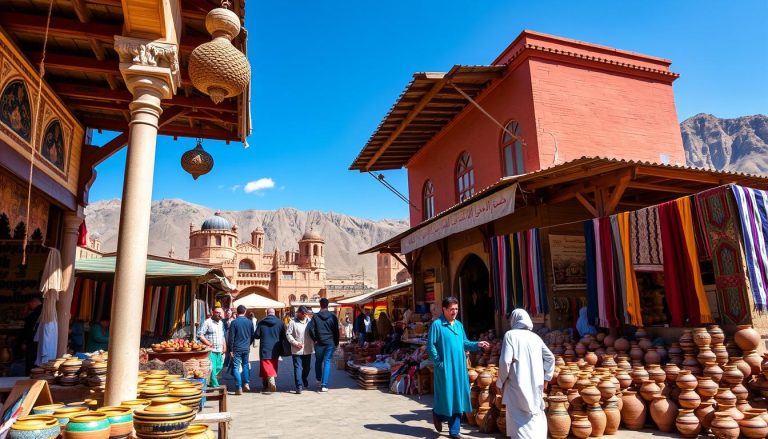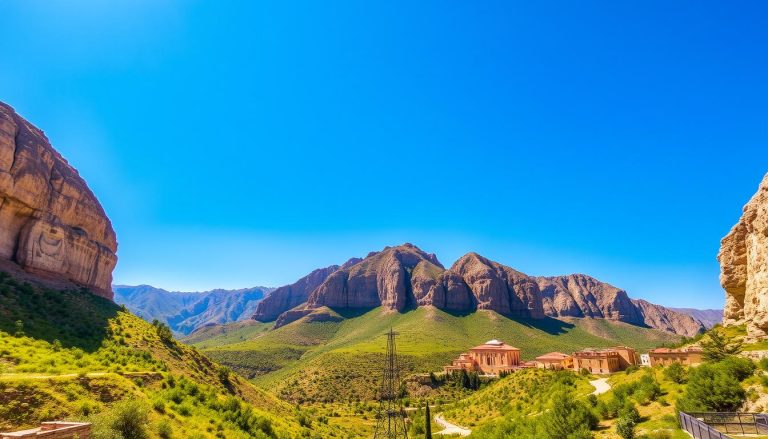Tabriz is a city in Iran’s northwest, where Persian and Azerbaijani cultures meet. It’s the biggest city in the country, filled with history, culture, and nature. This makes it a key spot for anyone interested in Iran’s culture.
What makes Tabriz special is its mix of East and West. It offers a unique experience for travelers looking for something different.
Ever wondered why Tabriz is so unique in Iran? It has amazing sights like the Tabriz Bazaar and the Blue Mosque. These places are must-sees.
Let’s explore the best things to do in Tabriz. We’ll dive into its history, culture, and natural beauty. You’ll be amazed and want to see more.
Key Takeaways
- Tabriz is Iran’s largest city, blending Persian and Azerbaijani influences.
- The city is home to renowned historical sites like the Tabriz Bazaar, a UNESCO World Heritage Site.
- Tabriz offers diverse activities, from visiting ancient Iron Age graves to shopping in the world’s largest indoor bazaar.
- The city’s cultural significance makes it an essential stop on any Iran cultural tour.
- Tabriz’s natural wonders, such as Elgoli Park and the Kandovan Village, provide a refreshing escape from the urban landscape.
A Historical Introduction to Tabriz: Where East Meets West
Tabriz is in the heart of Iranian Azerbaijan. It has a rich history that has shaped its culture. As a key trading hub on the Silk Road, Tabriz has always been a place where East and West meet. This has led to a lasting East-West cultural fusion seen in its language, buildings, and food.
The Cultural Significance of Iranian Azerbaijan
Tabriz is the biggest city in East Azerbaijan, Iran. It’s home to a lively Azeri community. The Azeris, with Turkic roots, have greatly influenced the Persian heritage here. Their traditions in language, art, and food have mixed with Iranian culture, creating a unique Tabriz history and identity.
Historical Timeline of Tabriz
- Tabriz became important in the 13th century under the Ilkhanate Mongols. It became a major center for trade and culture.
- In the 16th century, during the Safavid era, Tabriz was the Persian Empire’s capital. It drew scholars, artisans, and traders from everywhere.
- The city faced many challenges, including Qajar and Russian rule. But it remained a key part of Iranian Azerbaijan today.
Geographic Location and Climate
Tabriz is in northwestern Iran, surrounded by the Alborz mountains. It has a temperate, semi-arid climate. Its location, with mountains and valleys, makes it beautiful and popular for outdoor activities.
The Grand Bazaar of Tabriz: A UNESCO World Heritage Site
The Grand Bazaar in Tabriz, Iran, is a wonder to see. It’s a UNESCO World Heritage site. For centuries, it has been a key place for trade and social life in the city.
This huge Persian market covers over one square kilometer. It has 5,500 shops and many other buildings. In the Qajar era, 30% of Iran’s business happened here.
The bazaar’s design is both useful and beautiful. Its high ceilings let hot air out. Thick walls keep it warm in winter.
At the Tabriz Bazaar, you’ll find amazing things. There are Persian carpets, spices, and even modern gadgets. It’s near important sites like the Jame Mosque and Ali Qapu.
Looking for a special shopping trip or wanting to see Iran’s Silk Road trading history? The Tabriz Bazaar is perfect. It’s a lively Persian market that shows the city’s charm.
“The Tabriz Bazaar is not just a market, but a living, breathing piece of history that echoes the rich cultural heritage of Iran.”
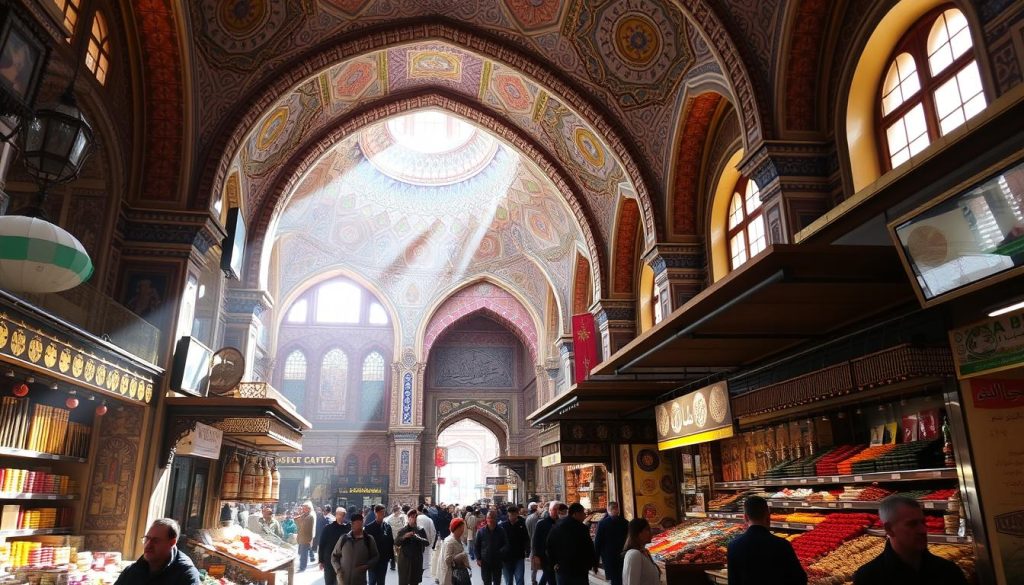
The Magnificent Blue Mosque: Architecture and History
In the heart of Tabriz, Iran, the Blue Mosque, or Goy Masjid, is a gem. It’s a symbol of the area’s rich Islamic architecture. Built in 1465 by Jahan Shah, it’s one of only four blue mosques worldwide.
Architectural Features and Design
The Blue Mosque’s blue tile work is its standout feature. These tiles cover the entire exterior. The mosque’s domes and arches add to its beauty, mixing Iranian Islamic and Ottoman styles.
The inside is filled with Persian calligraphy and patterns. These details make the mosque’s atmosphere truly mesmerizing.
Historical Significance and Restoration
The Blue Mosque has seen a lot, including two major earthquakes in 1727 and 1773. These disasters damaged the original complex, but the entrance iwan survived. Recent historical restoration has aimed to restore the mosque’s beauty.
Visiting Tips and Photography Spots
- The Blue Mosque is open daily. The best times for photos are morning or early afternoon.
- Don’t miss the mausoleum and tomb of Jahan Shah. It offers a deeper look into the mosque’s past.
- The northeast corner is perfect for photos. Its tile work and light play are stunning.
Despite natural disasters, the Blue Mosque in Tabriz is a treasure. It’s a key example of Islamic architecture and Persian tile work. Its beauty and history make it a must-see in Tabriz.
El Goli Park: Tabriz's Natural Retreat
In the heart of Tabriz, Elgoli Park, also known as Shah Goli, is a peaceful oasis. It’s a big urban green space with a calm lake at its center. Here, you can enjoy leisure, recreation, and family activities in a beautiful setting.
The park’s main draw is a traditional restaurant on a small island in the lake. You can get there by boat. It’s a favorite spot for both locals and tourists to enjoy Iranian food and the views.
Elgoli Park has lots to offer for all ages. There’s a mini-golf complex and even a place for national games. Next to the park, the Sayman Skate Sports Complex is a top spot for skaters from all over.
For fun rides, Luna Park by the lake has dodgem cars and carousels. Its green spaces and shaded areas are perfect for picnics, especially on weekends.
Boating on El Goli Lake is a hit in spring and summer. It’s a calm and enjoyable activity when the lake isn’t frozen.
Several hotels, like Pars El Goli Hotel and Shahriar Hotel, are close to the park. They offer great places to stay for those wanting to explore Tabriz’s natural beauty.
Looking for a peaceful picnic, exciting rides, or just a calm atmosphere? Elgoli Park is the place to be in Tabriz. It’s a great mix of urban green space and family-friendly attractions for a wonderful Tabriz recreation experience.
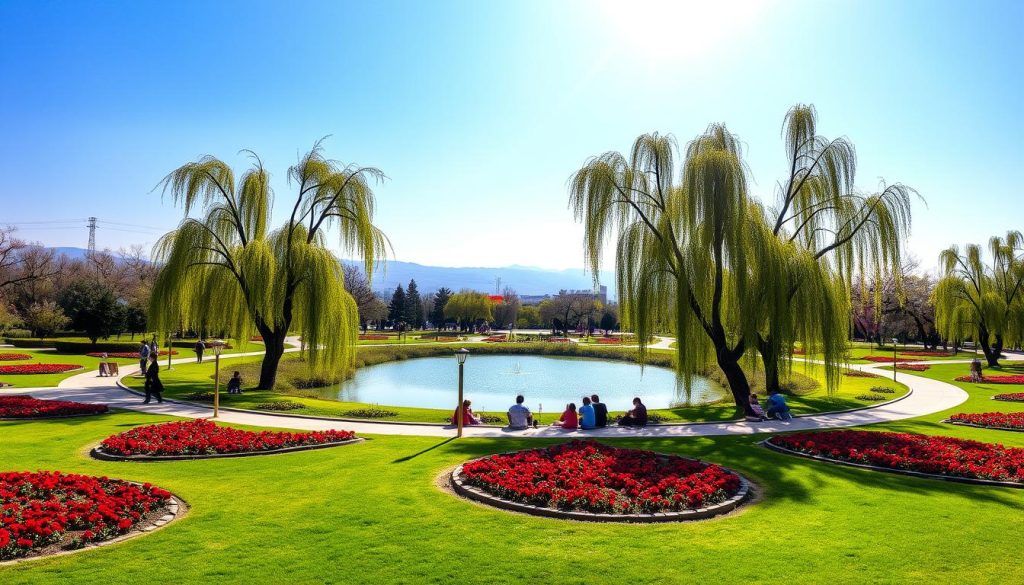
Kandovan Village: Iran's Cappadocia Experience
Kandovan is a village in East Azerbaijan, Iran. It’s often called Iran’s Cappadocia. The village has homes carved into volcanic rock, making it a stunning sight.
Traditional Cave Dwellings
Over 600 people live in Kandovan, making it the only rocky village with residents. The Kandis homes are carved into the rock. They have been expanded over generations, creating a network of homes and shops.
Local Life and Culture
Walking through Kandovan’s streets shows how locals live. They are known for their kindness and work in agriculture and crafts. Visitors can join festivals, visit markets, and talk to the friendly people.
Best Time to Visit
Winter is the best time to see Kandovan. The snow highlights the rock formations and homes. It’s also cooler than the summer, making it perfect for a break from the heat. A visit to Kandovan is unforgettable, taking you back in time.
Museums and Cultural Centers in Tabriz
Tabriz, the capital of Iran’s East Azerbaijan province, is known for its rich culture. It has many museums and cultural centers. These places let visitors explore the city’s history and art.
The Azerbaijan Museum is a key spot in Tabriz. It has artifacts from 7,000 years ago to today. You can see ancient pottery and coins from the Achaemenid Empire here.
The Iron Age Museum is near the Blue Mosque. It shows 38 graves from the Iron Age. This gives a peek into the burial customs of ancient times.
The Qajar Museum is in the Amir Nezam Garousi Estate. It has historical items and shows traditional Iranian architecture. It’s a window into the Qajar dynasty’s life and culture.
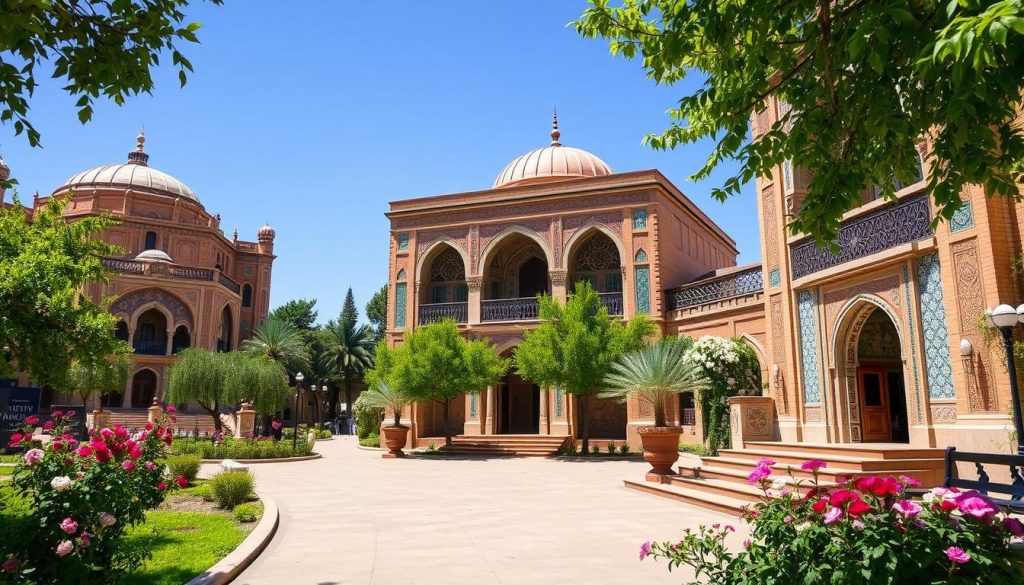
Tabriz also has many cultural centers. Places like the Mausoleum of Poets and Khaqani Park share their own stories. They invite visitors to dive into the city’s rich cultural scene.
The Constitution House: Symbol of Iranian Democracy
In the heart of Tabriz, the Constitution House is a key reminder of Iran’s history and its fight for democracy. This museum focuses on the Persian Constitutional Revolution of the early 20th century. It shows how Tabriz was crucial in this important time in Iranian history.
Historical Significance
The Constitution House honors Tabriz’s merchants who helped in the Persian Constitutional Revolution. This event aimed to reduce the monarchy’s power and start a parliamentary system. The city’s lively intellectual and political scene played a big role. The museum tells the stories of the brave revolutionaries who fought for democracy in Iran.
Architectural Elements
The Constitution House is a beautiful Qajar-era mansion. Its visitors are amazed by the stained-glass windows, ornate stuccos, and design. It mixes traditional Iranian beauty with modern touches. The museum shows Tabriz’s rich cultural history.
Exhibition Highlights
- Rare historical documents and artifacts from the Persian Constitutional Revolution
- Interactive displays and multimedia exhibits that bring the revolutionary era to life
- Biographies of key figures who led the fight for Iranian democracy
- Details on the social and political factors that influenced the revolution
Visiting the Constitution House is essential for anyone wanting to learn about Tabriz’s role in Iran’s democracy. This museum is a strong symbol of the city’s strength and the Persian Constitutional Revolution’s lasting impact.
Traditional Cuisine and Food Scene
Tabriz, the capital of Iran’s East Azerbaijan province, is known for its unique food. It combines Persian and Azerbaijani flavors. The city’s famous dish, Tabrizi Koofteh, is like Turkish Köfte in taste and name.
Tabriz has many restaurants, cafes, and street food vendors. Visitors can try authentic Tabrizi cuisine. They’ll find a wide range of dishes, from kebabs and rice to stews and appetizers.
Tabrizi Cuisine Highlights
- Tabrizi Koofteh: A dish reminiscent of Turkish Köfte, Tabrizi Koofteh is a meatball delicacy that showcases the blended influences of Persian and Azerbaijani cuisines.
- Khoresht: These Iranian stews, often combining vegetables like lentils, spinach, beans, or eggplant with meat, are a staple in local restaurants and home kitchens.
- Fesenjan: A unique Iranian stew made with ground walnut and pomegranate juice, Fesenjan is typically prepared during holidays and special occasions.
- Zereshk Polo: A traditional dish consisting of barberry rice, usually served with grilled chicken or alongside kebabs.
- Dizi or Abgoosht: A stone pot stew made with mutton soup, chickpeas, onions, potatoes, tomatoes, and turmeric, served with flatbread and pickled vegetables.
The food scene in Tabriz shows the region’s rich culture and people’s love for food. Trying Tabrizi Koofteh or other local dishes will impress your taste buds. Tabriz offers a Tabrizi cuisine experience you won’t forget.
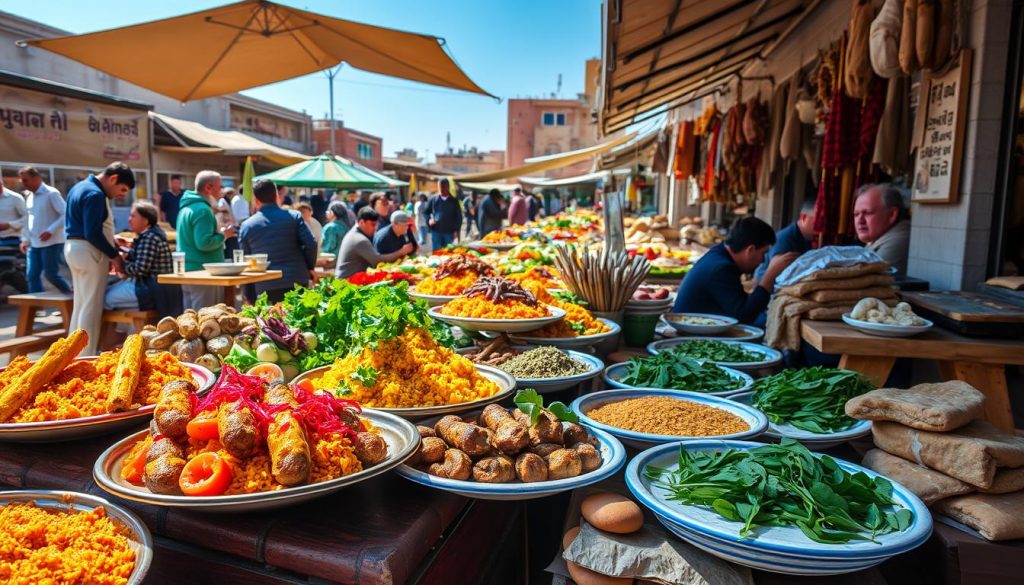
Tabriz Shopping Guide: Beyond the Bazaar
The Grand Bazaar is a top spot for shopping in Tabriz. But, the city has more to offer. Explore Tabriz’s modern retail scene for a wide range of handicrafts, souvenirs, and modern retail. You’ll find local treasures that show off the area’s rich culture.
Tabriz is famous for its carpets and textiles. Artisans here make some of Iran’s finest rugs and termeh (woven silk fabrics). You can find these items in the Grand Bazaar and other shops around the city. Discover unique gifts and souvenirs that truly represent Tabriz.
Artisanal Treasures and Local Handicrafts
Tabriz has a lively community of artisans and craftspeople. Wander the city’s side streets to find workshops. Here, you’ll see amazing pottery, jewelry, and traditional clothing being made. Look for turquoise ornaments and Giveh (traditional Iranian shoes) for a taste of the region’s culture.
| Handicraft | Description | Unique Features |
|---|---|---|
| Persian Rugs | Tabriz is famous for its high-quality hand-woven Persian rugs. They come in 19 subgroups like Shah-Abbasi and Paisley. | These rugs are known for their exceptional craftsmanship, vibrant colors, and intricate designs. |
| Pottery | Iranian pottery has a long history, with different styles and techniques in each region. | Tabriz is known for its colorful and intricate pottery, often with traditional motifs. |
| Traditional Textiles | Tabriz is famous for its termeh (woven silk fabrics) and Giveh (traditional Iranian shoes). | Termeh weaving dates back to the Safavid era, while Giveh-making is a unique craft in Iran. |
Dive into the world of Tabriz shopping and find a wealth of artisanal goods. From beautiful rugs to intricate pottery and traditional textiles, these souvenirs will remind you of your time in Tabriz.
Day Trips and Excursions from Tabriz
Tabriz is Iran’s fifth largest city and a great spot for exploring. It’s close to many cultural sites and natural wonders. These day trips can make your visit to Tabriz even better.
St. Stephanos Monastery: A Cultural Gem
The St. Stephanos Monastery is a 9th-century Armenian church in Jolfa. It’s set in a beautiful valley. This place is a key part of the Armenian heritage and a top choice for Tabriz day trips.
Eynali Mountain Range: Hiking and Panoramic Views
The Eynali Mountain Range is perfect for outdoor lovers. You can drive, walk, or take a telecabin to the top. There, you’ll find amazing views of Tabriz and other regional tourism spots.
Exploring the Region's Attractions
Tabriz is also near many other regional attractions in Iranian Azerbaijan. You can see the unique troglodyte homes in Kandovan Village. There are also many historical sites and natural wonders around.
Tabriz has something for everyone. Whether you love culture, adventure, or just beautiful views, there are many day trips to choose from. These trips can make your trip to Tabriz even more memorable.
| Attraction | Distance from Tabriz | Highlights |
|---|---|---|
| St. Stephanos Monastery | 20 km west of Jolfa | 9th-century Armenian church, picturesque valley setting |
| Eynali Mountain Range | Within Tabriz | Hiking trails, panoramic city views, telecabin transport |
| Kandovan Village | 70 km southwest of Tabriz | Troglodyte cave dwellings, traditional rural life |
“Tabriz’s location makes it an ideal starting point for exploring the diverse attractions of Iranian Azerbaijan. From historic monasteries to natural wonders, there is no shortage of adventure and cultural discovery awaiting visitors.”
Conclusion
Your trip to Tabriz has shown you a city full of history, culture, and beauty. You’ve seen the Grand Bazaar, the Blue Mosque, and Kandovan village. These places show Tabriz’s mix of Iranian-Azerbaijani culture.
Tabriz is great for history buffs, architecture lovers, and foodies. It’s a place where you can dive into local culture and markets. Plus, it’s close to other amazing spots in northwestern Iran, like Tehran’s Golestan Palace and Persepolis.
Looking back on your Tabriz adventure, think about the city’s strength and the kindness of its people. Tabriz has beautiful landscapes, historical sites, and a lively culture. It’s a place that will stay with you and make you want to come back for more.
